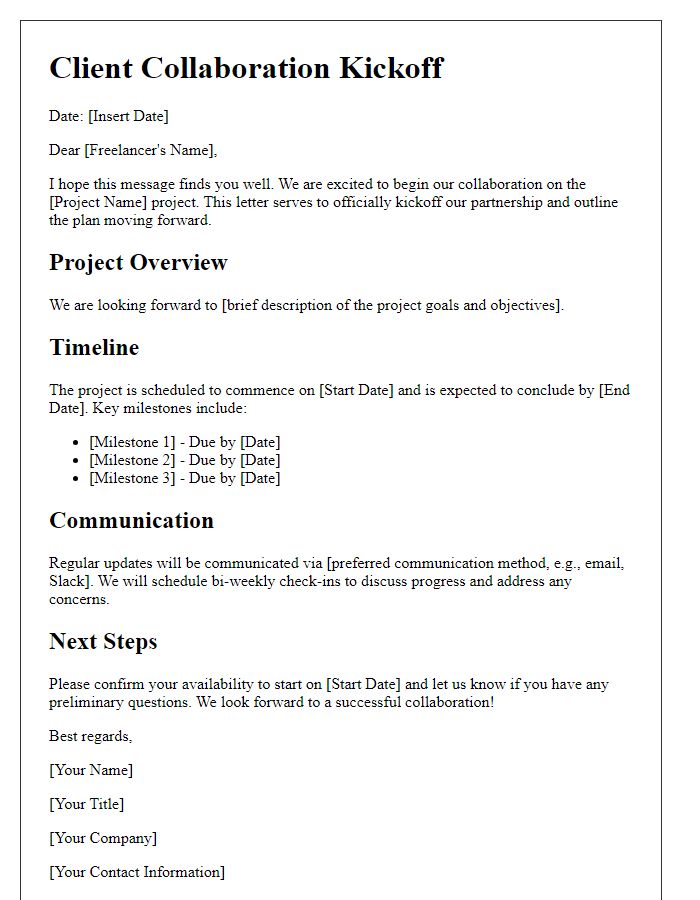Welcome to the exciting world of freelance collaboration! Whether you're a seasoned client or new to the process, the onboarding experience can set the stage for a successful partnership. It's all about clear communication and understanding project expectations to help both parties thrive. Ready to dive deeper into how to make your freelance onboarding seamless? Let's explore more!

Client Introduction and Background
Freelance client onboarding begins with a thorough understanding of the client's business and specific needs. A detailed client introduction provides insight into the industry, such as annual revenue figures, market position, and customer demographics. Background information might include the company's founding year, significant achievements, and key competitors in the sector. Knowing the client's preferred communication channels, project management tools, and deadlines enhances collaboration. Understanding the client's target audience and current challenges enables tailored solutions that align with their objectives. A well-rounded introduction ensures a smooth onboarding experience, laying the groundwork for a successful working relationship.
Scope of Work and Deliverables
Freelance client onboarding involves establishing a clear Scope of Work (SOW) and delivering specific outcomes tailored to client needs. The SOW outlines project objectives, timelines, and the specific tasks to be completed, such as website development or marketing strategy creation. Deliverables might include a fully functional e-commerce site, social media content calendar, or a comprehensive market analysis report. These components are crucial for ensuring alignment between the freelancer and client expectations, which fosters successful collaboration and satisfaction throughout the project lifecycle.
Timeline and Milestones
Freelance projects often require clear timelines and defined milestones for successful execution. For instance, in a digital marketing campaign for a small business launching in New York City, a timeline might set initial research and strategy development for two weeks, starting from the project kickoff on March 1, 2024. Subsequent milestones could include a website audit by March 15, content calendar deliverable by March 30, and campaign launch on April 15. Each milestone could involve specific tasks, such as keyword research, competitor analysis, or ad creation, with deadlines and deliverables clearly outlined to ensure accountability and track progress. Regular check-ins every two weeks during the project phase would facilitate communication and adjustments as needed.
Pricing and Payment Terms
Freelance clients should establish clear pricing structures to ensure transparent financial transactions. Common pricing models include hourly rates, project-based fees, or retainer agreements. For example, an hourly rate might range from $25 to $150, depending on the freelancer's expertise and industry standards in places such as New York or San Francisco. Payment terms typically outline when payments are due, often specifying net 30 or net 15 days post-invoice. Freelancers may require upfront deposits, commonly 20% to 50%, before project commencement. Methods for payment, including PayPal, bank transfers, or platforms like Upwork, should also be defined to streamline transactions and enhance client-freelancer communication.
Communication and Contact Information
Effective communication is crucial for successful freelance projects, ensuring clarity and understanding between freelancers and clients. Establishing contact information, such as email addresses, phone numbers, or communication platforms like Slack or Zoom can facilitate timely discussions. It's essential to agree on preferred communication methods to streamline updates and feedback. Regular check-ins, whether weekly or biweekly, can help monitor project progress and address any concerns early, allowing for adjustments as needed. Additionally, defining response time expectations promotes accountability and conveys professionalism. Maintaining an organized approach to sharing documents and files through platforms like Google Drive or Dropbox enhances collaboration and accessibility.













Comments